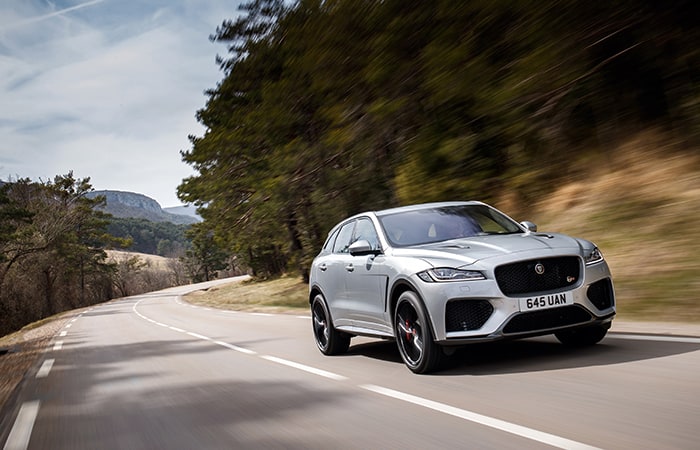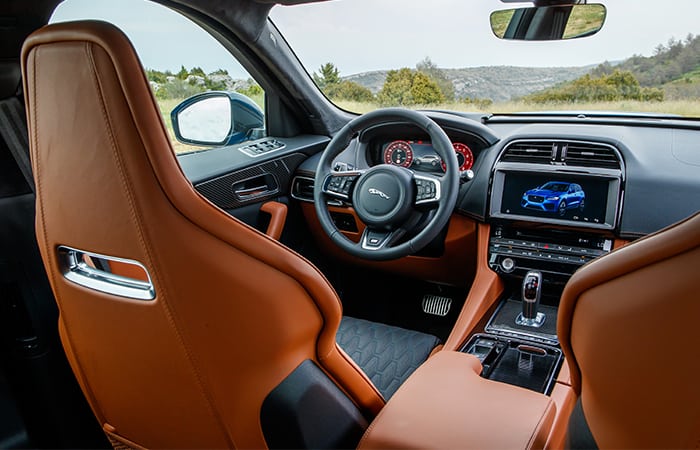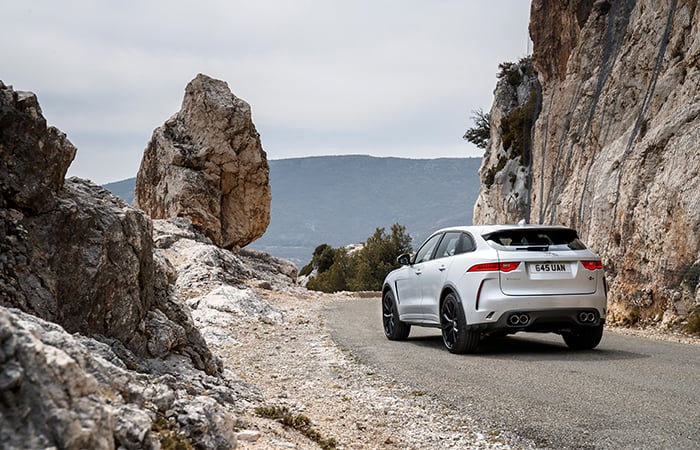"We call this thing The Magnificent Beast,” jokes Ross Restell, lead engineer for vehicle dynamics at JLR’s Special Vehicles Operations department. He’s referring to the new Jaguar F-Pace SVR that sits waiting for us across the car park. Just then, one of the cars starts up, its 5-litre supercharged V8 roaring into life like an angry lion woken from its slumber. I swear you can feel the ground shake.

We’ve been here before, of course. Luxury SUVs are big business and that means premium manufacturers are scrambling to outdo each other in the world of super-fast, super-sized off-roaders. Alfa Romeo has the Stelvio Quadrifoglio, Porsche has the Cayenne Turbo and even Jaguar’s sister company Land Rover has an indirect rival in the form of the Range Rover Sport SVR.
But while the Range Rover Sport SVR is a gloriously silly hot rod that blends laugh-out-loud performance with Land Rover’s traditional mud-plugging capabilities, the F-Pace SVR is an altogether more serious attempt at a performance car. It has a very credible base in the standard F-Pace – already one of the best handling SUVs on the market – and a lot of work has gone into creating a civilised, well-rounded package.
“We inherited a great car to start with,” comments Restell. “The F-Pace is already extremely rigid so we were able to get the performance and the handling characteristics we wanted without having to make any changes to the fundamental structure. It’s mainly aluminium so it’s also comparatively light and the suspension already has a suitable layout with double wishbones at the front and an integral link setup at the rear.”
The most obvious change is the addition of the vast supercharged V8 that’s currently causing the air around us to pulsate. It’s essentially the same unit as you’ll find in top-of-the-range versions of everything from the F-Type to the Range Rover.
However, this marks the first time that this engine has been installed in the F-Pace. The results are startling. Despite an unladen weight of more than two tonnes, the 542bhp (550PS) V8 is capable of catapulting the F-Pace SVR from 0 to 60mph in just 4.1 seconds. That’s faster than a Ferrari 360 Modena in a car with ample room for five people and a boot large enough for a pony. Top speed is an almost equally barmy 176mph.
Other changes include a set of giant alloy wheels (21-inch as standard, with optional 22-inch wheels fitted to our test car). Inside those you’ll find an equally gigantic set of brake discs (396mm at the rear and 396mm at the front) charged with hauling this beast back to a standstill.

The calm before the storm
We climb into the beautifully appointed interior and point the F-Pace SVR’s nose north from St Tropez towards the Route Napoleon and the Southern Alps. Aside from a flare of revs when the engine starts, it’s a very refined experience. The V8 dies down to a distant rumble, the eight-speed ZF automatic shuffles gears seamlessly in the background and the ride – even on those monster truck wheels – has that classic Jaguar blend of compliance and composure.
We find ourselves stuck behind a truck as the road starts to snake its way up into the mountains. A short straight opens up ahead so I flick the drive selector over to Dynamic and pin the accelerator to the bulkhead. A wall of sound erupts from the SVR’s tailpipes. With no turbochargers to worry about, the response is instant, the torque delivery is unswervingly linear and the thrust is seemingly never-ending. It’s as if the road ahead has been compressed by magic.
A few corners later, I’m even more convinced that the SVO engineers have turned to voodoo. Whereas some fast 4x4s squat down on their haunches when you accelerate hard and roll around in the corners, the F-Pace stays level and composed. The same applies to braking, with more than enough retardation to haul this two-tonne projectile down from the somewhat alarming velocities it is able to achieve. You never entirely lose that sense of mass, but at no point does it feel like an impediment. There’s a real sense of involvement here too, with well-weighted steering that responds faithfully to your inputs and a chassis that seems to pivot directly about your hips.

But what’s remarkable about this car is the way it combines the mild-mannered Dr Jekyll and the savage Mr Hyde into one coherent package. As Restell explains when we catch up later on, it’s this elusive balance between ride and handling that proved the biggest challenge for the SVO engineers.
“We would sometimes spend a week at the Nürburgring developing an incredible track set-up. It would seem OK driving back on the continental motorways, but as soon as we rolled off the train into the UK we’d realise that it had become too track-focused,” he comments. “We’d then spend two or three weeks driving around the roads of the UK to wind that back out before we’d have to return to the track to ensure we’d got the balance right.”
“It’s these systems that give the F-Pace SVR its remarkable ability”
Part of this transformation lies with the hardware. The springs are now 30 per cent stiffer on the front and 10 per cent stiffer on the rear. There have also been revisions to the bushes, the spring aids and the anti-roll bars, along with the internal components used in the Bilstein Continuously Variable Damping system. Elsewhere, there’s a new electronically controlled rear differential, capable of varying the locking torque to strike a balance between traction and stability (for instance, allowing the rear inside wheel to spin on a damp corner to prevent excessive oversteer). Meanwhile, the fore-and-aft split can also be constantly adjusted, with anywhere from 50 to 100 per cent of torque sent to the rear wheels. On top of all this, there’s a brake-based torque vectoring system that can occasionally be felt helping the car to pivot into the corners. It’s these systems that give the F-Pace SVR its remarkable breadth of ability.
No less than 250 different software calibrations were apparently tested before the SVR was finally signed off. Earlier on in the process, JLR’s driver-in-the-loop simulator in Gaydon had been used extensively, allowing the ride and handling engineers to drive a virtual model of the car. The roads around the development centre were digitised using a laser scanning process to capture every bump and camber. Similar techniques were used to create virtual representations of test facilities such as the Nürburgring. This helped the engineers to narrow down the hardware choices before they moved on to physical prototypes for the fine-tuning.
Given all the performance and technology involved, the F-Pace SVR actually starts to look like quite good value at its starting price of £74,835. Of course, there are those who will tell you that an SUV capable of hitting 176mph is excessive. And they’re not wrong. But there are a few things to consider: It’s a stunning engineering achievement that acts as a halo product in an industry where SUVs are big business and this particular variant will only ever account for a tiny percentage of F-Pace sales. A lot of the lessons learnt on this project will translate well to other areas of the business (particularly when it comes to engineering dynamism into electric vehicles laden with batteries).
And finally, it seems that the days of big, loud combustion-engined cars like this may soon be numbered, so we should enjoy this magnificent beast while the opportunity still exists. With that in mind, I’m heading back up into the mountains.
MORE ON AUTOMOTIVE




Nanogenerator consumes CO2 to generate electricity
Whoopee, they've solved how to keep a light on but not a lot else.